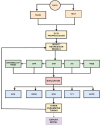Enhanced SOC estimation of lithium ion batteries with RealTime data using machine learning algorithms
- PMID: 38992178
- PMCID: PMC11239840
- DOI: 10.1038/s41598-024-66997-9
Enhanced SOC estimation of lithium ion batteries with RealTime data using machine learning algorithms
Abstract
Accurately estimating Battery State of Charge (SOC) is essential for safe and optimal electric vehicle operation. This paper presents a comparative assessment of multiple machine learning regression algorithms including Support Vector Machine, Neural Network, Ensemble Method, and Gaussian Process Regression for modelling the complex relationship between real-time driving data and battery SOC. The models are trained and tested on extensive field data collected from diverse drivers across varying conditions. Statistical performance metrics evaluate the SOC prediction accuracy on the test set. Gaussian process regression demonstrates superior precision surpassing the other techniques with the lowest errors. Case studies analyse model competence in mimicking actual battery charge/discharge characteristics responding to changing drivers, temperatures, and drive cycles. The research provides a reliable data-driven framework leveraging advanced analytics for precise real-time SOC monitoring to enhance battery management.
Keywords: Comparative analysis; Electric vehicle; Gaussian process regression; Lithium-ion battery; Machine learning; State of charge.
© 2024. The Author(s).
Conflict of interest statement
The authors declare no competing interests.
Figures



















References
-
- Xie J, Wu C, Le ADT, Abeywardana IU, Paul B, Hussein A. Battery electric vehicles for modern power systems—A comprehensive review on technological evolutions and integration paradigms. Renew. Energy. 2022;183:459–489.
-
- Liu Z, Zhang Q, Huisingh D, Wang Y. Carbon emissions of electric vehicles based on electricity generation mix: A regional assessment of China. Renew. Energy. 2021;163:1217–1233.
-
- Wang Z, Zhang X, Sun Y, Liu W. A comprehensive overview of hybrid electric vehicles. Appl. Energy. 2020;269:115054.
-
- Zhang X, Sahinoglu Z, Wada T, Hara S, Sakurai J. Recent progress on lithium ion battery performance degradation analysis and state estimation technologies: A review. J. Energy Storage. 2020;28:101230.
-
- Chu S, Majumdar A, Pan J, Chiang YM, Wu Z. Why are commercial lithium ion batteries unstable? An overview of stability issues, consequences, and remedies. J. Power Sources. 2021;493:229562.
Grants and funding
LinkOut - more resources
Full Text Sources

